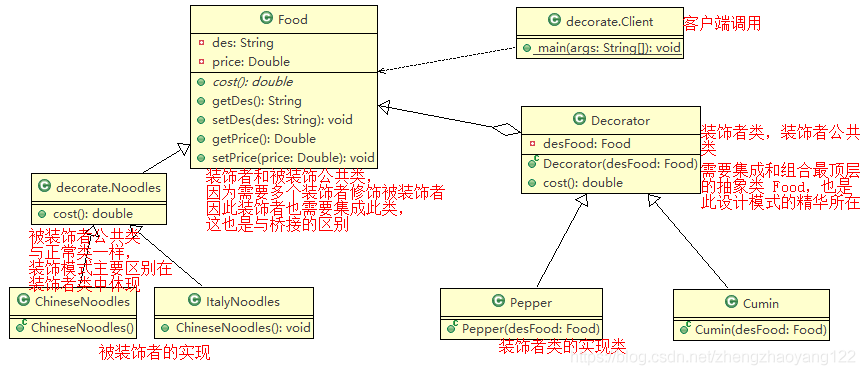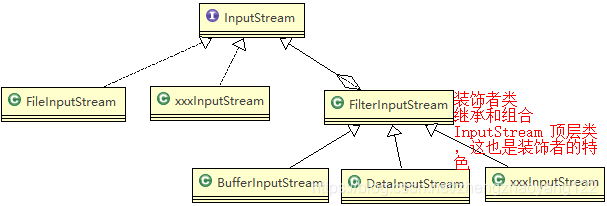现实生活中常常需要给某类产品动态增加新的功能,如:给面条各种调味品。在软件开发过程中,有时想用一些现存的组件。这些组件可能只是完成一些核心功能。但在不改变其架构的情况下,可以动态地扩展其功能。所以这些都可以采用装饰模式来实现。
# 一、装饰者定义
【1】装饰者模式: 动态的将新功能附加到对象上。在对象功能扩展方面,它比继承更有弹性,装饰者模式也体现了开闭原则。
【2】设计模式属于结构型模式。
【3】这种模式创建一个装饰类,用来包装原有的类,并在保持类方法签名完整性的前提下,提供了额外的功能。
【4】优点: 装饰类和被装饰类可以独立发展,不会相互耦合,装饰模式是继承的一个替代模式,装饰模式可以动态扩展一个实现类的功能。
【5】缺点: 多层装饰比较复杂。
# 二、装饰者类图

# 三、案例代码分析
【1】定义一个装饰者和被装饰者都需要集成的抽象类(Food 食物)
public abstract class Food {
private String des;
private Double price;
//其他类需要实现的抽象方法
public abstract double cost();
//get/set方法省略
}
2
3
4
5
6
7
8
【2】被装饰者需要继承的类(Noodles 面条)
public class Noodles extends Food{
//这里获取到的价格是子类实现时设置的价格
@Override
public double cost() {
return super.getPrice();
}
}
2
3
4
5
6
7
【3】被装饰者具体的实现类之一(ChineseNoodles 中式面条)
public class ChineseNoodles extends Noodles{
//构造器中只需要定义该产品的价格和描述,因为它是被装饰者,与平常类一样
public ChineseNoodles() {
setDes("中式面条");
setPrice(25.00);
}
}
2
3
4
5
6
7
【4】装饰者类都需要集成的公共类
public class Decorator extends Food{
//将被装饰者组合进来
private Food desFood;
//构造器将其引入
public Decorator(Food desFood) {
this.desFood = desFood;
}
//将自己的价格与被装饰者价格进行成绩
@Override
public double cost() {
System.out.println(desFood.getDes() +"价格:"+desFood.getPrice()+ "配料如下:"
+super.getDes()+"价格:"+this.getPrice()+"总价"+(super.getPrice()+desFood.cost()) );
//价格总计
return super.getPrice()+desFood.cost();
}
}
2
3
4
5
6
7
8
9
10
11
12
13
14
15
16
【5】装饰者实现类之一
//孜然类
public class Cumin extends Decorator{
//构造器
public Cumin(Food desFood) {
super(desFood);
setDes("孜然");
setPrice(2.00);
}
}
2
3
4
5
6
7
8
9
【6】客户端调用: 优点,一个产品可以被多个装饰者装饰,同时装饰者和被装饰者扩展时都非常灵活,只需要扩展自己的类即可,无需修改其他类。
public class Client {
public static void main(String[] args) {
//先定义一个被装饰者,返回对象要为最顶层的对象,这样被装饰者才能接受
Food noodles = new ChineseNoodles();
//定义一个装饰者对象
Food cumin = new Cumin(noodles);
//输出为:中式面条价格:25.0配料如下:孜然价格:2.0
cumin.cost();
//再定义一个装饰者 Pepper辣椒类
Food pepper = new Pepper(cumin);
//输出为:中式面条价格:25.0配料如下:孜然价格:2.0配料如下:辣椒价格:1.0总价28.0
pepper.cost();
}
}
2
3
4
5
6
7
8
9
10
11
12
13
14
15
# 四、装饰者模式在JDK应用的源码分析
【1】JDK 中流的使用用到了装饰者模式。从下面的客户端使用能够得出 FileInputStream 是被装饰者,DataInputStream 是装饰者类的一个实现类,下面就进入 FileInputStream 中查看源代码:
public class Decorator {
public static void main(String[] args) throws Exception{
DataInputStream dis = new DataInputStream(new FileInputStream("d:\\a.txt"));
}
}
2
3
4
5
【2】FileInputStream 继承了 InputStream ,也就是上面提到的 Food 类及 ChineseNoodles 之间的关系。
public class FileInputStream extends InputStream{
......
}
2
3
【3】进入 DataInputStream 装饰者类的实现类
public class DataInputStream extends FilterInputStream implements DataInput {
/**
* 构造器,将顶层接口 进行组合,父类装饰类的重写
*/
public DataInputStream(InputStream in) {
super(in);
}
}
2
3
4
5
6
7
8
9
【4】最重要的部分:装饰者类 FilterInputStream 继承和组合了 InputStream 接口,被装饰者也实现了此接口。
//集成最顶层 InputStream 接口,被装饰者也集成的接口,因为此类的返回值要与被装饰类类型相同
public class FilterInputStream extends InputStream {
/**
* 组合 被装饰者类
*/
protected volatile InputStream in;
/**
* 构造器
*/
protected FilterInputStream(InputStream in) {
this.in = in;
}
}
2
3
4
5
6
7
8
9
10
11
12
13
14
【5】源码类图如下:与装饰者类的类图一致,易理解。
